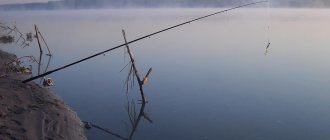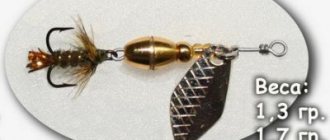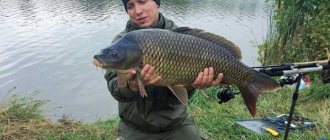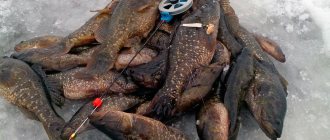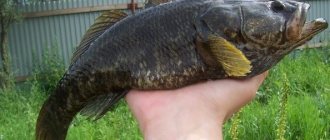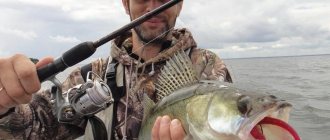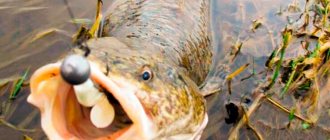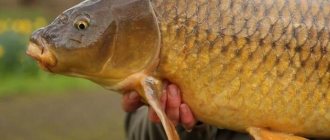Choosing a reservoir
Rotan prefers stagnant bodies of water with a large number of shelters in which this fish can ambush.
What should you pay attention to when choosing a reservoir for catching rotan?
- The presence of a large predator in the reservoir . The best bodies of water for fishing are small ponds and lakes, in which rotan is the only predatory fish. Here it feels most comfortable, reproduces in large quantities and reaches a respectable size. If perch and pike are present in a pond or lake, they cause great damage to the sleeper population.
- Amount of aquatic vegetation . When choosing a reservoir for catching rotan, you should pay attention to the amount of aquatic vegetation. This fish feels best in heavily overgrown ponds and lakes. It is much more difficult to catch rotan in clear water.
- Age of the reservoir . The older the reservoir, the larger rotan can be expected in it.
Accessibility also plays an important role: an abundance of large rotan is more likely to be expected in ponds that are very difficult to reach.
Promising fishing spots
Promising points for catching rotan are:
- thickets of aquatic vegetation;
- areas of a pond or lake where the surface of the water is covered with duckweed or fallen leaves;
- driftwood lying at the bottom, tree trunks, boulders, piles of garbage, tires.
Rotan, which needs shelter in order to feel safe, is very willing to settle under a carpet of duckweed or fallen leaves covering the surface of the water.
But, as a rule, the largest specimens of rotan stand precisely in thickets of aquatic vegetation . You can catch them by fishing at the edge of thickets or in windows.
Spinning rod for catching rotan
Rotan is a small fish , and it is usually caught with small baits in standing water at shallow depths. the lightest tackle for catching this fish .
Rod
ultralight class rod , with a test weight of up to 7 or up to 9 g and a length of about 2.2 - 2.3 m.
A spinning rod with a soft monolithic tip with a dough weight of up to 5 - 6 g is ideal for microjig fishing.
A rod with a rigid tip and a weight of up to 9-10 g will be more universal. Such a spinning rod will allow you to fish with larger baits, perform sharper retrieves if necessary, and twitch wobblers.
Coil
There are no special requirements for the reel when fishing for rotan. Any spinning reel , which will go well enough with the fishing rod used and the fishing line used. It is also worth remembering the ratio of price and quality.
fishing line
Any fishing enthusiast will confirm that the choice of fishing line plays an important role, because your catch largely depends on it. The best choice for catching rotan is a braided line with a real test of about 6 lb.
Equipment
The dropshot rig consists of only two components:
- sinkers
- and hook
The sinker is attached to the end of the fishing line using a carabiner with a clasp or a blind one. And higher up the fishing line at a distance of 30 to 50 cm, a hook without a leash is attached (with a knot directly on the main fishing line). The hook depends on the size of the fish; for a medium-sized rotan, a 7 will do, and for a standard 10 of the Russian numbering.
Use elongated weights in a rubber tube (they are much less prone to snagging).
A silicone bait is attached to the hook (these can be twisters, worms (wake), vibrotails). You can attach it either using the standard jig method or to the center of the bait or the front part. The worms are pierced in the center.
Drop shot weights, including a long non-snagging weight in a rubber tube
Selection of baits
For this fish you can consider the following bait options :
- Twisters . Silicone baits are most effective when fishing for rotan using spinning. A small two-inch twister would be a good choice.
- Wacky . A wacky is a worm made from flavored silicone (called "edible rubber"). One of the most effective baits for catching rotan using a spinning rod.
- Rotating spoons . When fishing for rotan, rotating spoons can be used in shallow water areas where the bottom is covered with a continuous, even carpet of underwater vegetation. Aglia-type spinners with a petal shape will be the optimal choice for catching rotan.
- Wobblers . When fishing for rotan, you can successfully use minnow wobblers, suspended or floating (slowly floating), with a length of 25 to 60 mm.
When fishing for rotan, it is important to make sure that the bait falls to the bottom as slowly as possible .
The following equipment is suitable for this :
- silicone bait on a light (no more than 1.5 - 2 g) jig head;
- drop shot;
- split shot;
- bombard.
Further, as for the leash, when fishing with standard or spaced rigs, you can use a fluorocarbon leash about 20 centimeters or more in length. This can help increase the number of bites, since fluorocarbon is almost invisible in the water.
Equipment and installations
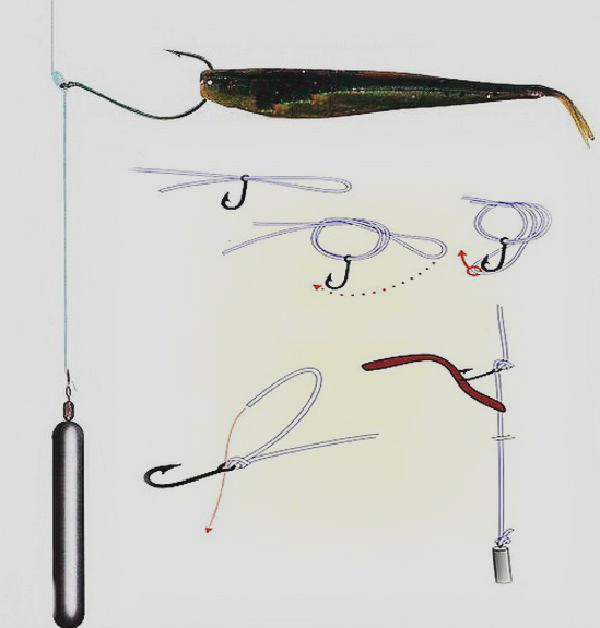
In the spring, already with the appearance of the first significant thawed patches, the “smut” begins to be interested in food. At this time, the predator is passive and will not chase a passing spinner or spooner.
For fishing in cold water, it is convenient to use spaced rigs, among which the drop shot stands out. This method of fishing allows you to move the bait at a very low speed, which will certainly appeal to slow rotans. A silicone fish or worm twitching almost in one place will certainly provoke a predator standing in ambush. Wiring consists of the following steps:
- Play along with the tip of the rod, trying not to move the load from its place.
- Dragging the equipment 20-30 cm and continuing the game.
Note! Sometimes it is possible to persuade a lethargic rotan by playing very long and delicately in one place. The predator can simply study the object for some time without giving away its presence. Movements of the tackle should be minimized, but the animation should be diluted with long (10-15 seconds) pauses.
Another equipment suitable for spinning fishing for rotans in overgrown reservoirs is a wacky. This installation is an unloaded “rubber” attached to a hook in the middle of the body. The bait plays well in free fall, swaying from side to side. The wiring turns out to be original and slow, which again suits the “Russian bass”. Of the variety of silicone baits, small worms are best.
Recommended reading: How to catch an asp using a spinning rod
The wiring consists of the following manipulations:
- We throw out the equipment and wait until it reaches the bottom (the bite may already be at this phase).
- Having waited for the landing, we begin to make small jerks with obligatory pauses.
As in the case of drop-shot equipment, the duration of pauses depends on the activity of the rotan.
Important. After the ice melts, the fish becomes even more passive.
At this time, the wiring should be as slow as possible, and the twitching should be of low amplitude. After just one or two weeks, the melt water warms up a little under the spring sun and the firebrand begins to respond to faster play.
Conditions for successful fishing
On clear days, rotan bites best on a spinning rod within a few hours after sunrise.
In the middle of the day, its bite weakens and becomes active again in the evening.
In cloudy weather , rotan is usually active throughout the day. With a sudden change in weather, rotan practically stops feeding.
When choosing a day for rotan fishing, it is worth taking into account the wind : if it is strong, it will interfere with fishing, since very light baits and sinkers are used when fishing for rotan.
Activation of rotan biting occurs at reduced pressure before increasing.
Fishing technique
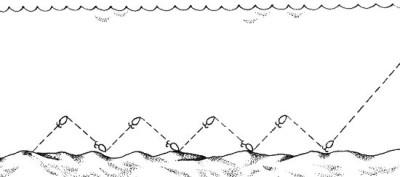
Some anglers practice retrieving when casting . But it is worth remembering that with such tactics, slow and smooth retrieval of the bait .
The optimal way to retrieve a weki worm is to slowly rotate the reel handle, twitch the bait with the tip of the spinning rod, and pause.
When fishing with a drop shot, you can play with the bait, leaving the sinker motionless on the bottom.
The optimal wiring option when fishing with wobblers is fairly soft twitching with pauses.
Bite and hook
In different situations, the bite of rotan can be decisive and greedy or, on the contrary, very cautious. Accordingly, in some cases (for example, when fishing with a twister with a jig head), the hook is usually immediate, while in others (fishing with edible rubber weckies ) it is better to give the fish a little time to chew the bait.
Catching rotan using a spinning rod
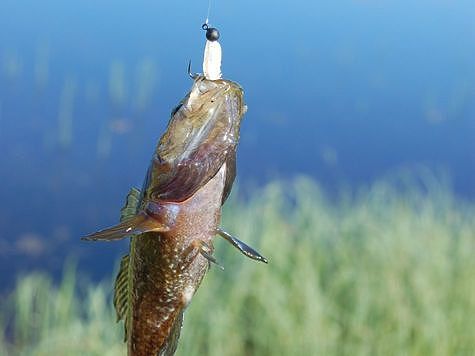
At the end of May, when the aquatic vegetation has developed sufficiently, I always have fun catching this peculiar fish at least once every year.
Traditional fishing with a float rod with a worm on a hook or with a jig with a side nod was quite boring due to its primitiveness, so I tried a spinning rod.
This happened a couple of years ago, although I had previously made frantic attempts to catch rotan with a spoon or wobbler. Rotan sometimes came out of hiding, followed the bait with his eyes and returned to the grass thickets.
I decided to try to catch rotan using silicone. Reflections led me to reject the unloaded option in advance. It was difficult to imagine that a light vibrotail would be able to penetrate deep into the thick vegetation. To break through the layer of duckweed on the surface, a decent weight was needed. I chose a jig head.
Fishing with light bait involves the use of very sensitive gear. It may seem strange, but for rotan this quality turned out to be more important than, for example, for catching “dumb” trout in a “carp pond”.
I used a Pontoon 21 Stylo SL 732L-T spinning rod, 0.18 mm monofilament so that I could rip the bait out if it got caught, jig heads from C'ultiva with thin wire hooks and soft baits from Pontoon 21 and Herakles.
The place for fishing is a pond on the edge of the forest near the dacha, which turns into a “swamp” in summer. The water is clear and in Polaroids the bottom can be seen at a distance of up to 10 m.
On my first fishing trip, I started fishing without much faith in success, but with the mindset to fight my own pessimism. Test runs in the open in wide grass gaps brought a couple of bites.
While I caught the second fish, I had to throw all the convenient places in the gaps. There are very few such places on lakes, which practically become swamps by the beginning of summer, and it is not possible to get close to the water everywhere because of the marshy banks.
Actually, I didn’t pick up a spinning rod in order to catch rotan, where it can be caught without straining using a float or nod rig. The task was to catch him in the thick of the grass, directly in the places of his ambushes.
To do this, I took heads weighing 0.6 and 0.9 g with an Awaruna 1.5-inch vibrating tail and a Ghost shad 5 cm.
Casting into thickets of horsetail with pondweed and very short sharp jerks (2-5 cm each) in order to pull the bait through the plants.
Every four to five jerks, slowly pull the bait ten to twenty centimeters. And that's where it began!
Literally every cast brought fish. It is characteristic that there were no repeated bites from one point, which is not surprising, since rotan is an ambush predator.
The bites were recorded perfectly. Still, it’s good that you took good gear.
But there was a small problem. The predator managed to grab the bait so deeply that it was necessary to use the trap several times, but all the caught fish remained alive and after the photo session were returned to their native element.
After fishing, I was left with a feeling of some doubt - everything went too smoothly. In such cases, I always besiege myself with joyful cries - I am a champion!
It is clear that it is not only a matter of gear and skill, but also a combination of weather, fishing time, chosen place and, of course, the desire of the other party to participate in the experiment.
I would also like to note the following. Each athlete develops and remains for the rest of his life analyzing and fixing the tempo of fishing on a subconscious level.
For many years I have been catching rotan closely using a large jig with a bunch of white maggots. I lowered the bait into the “window” of the plants, played, the jig disappeared - that means there was a bite. And so from window to window.
So, this time the rate of effective fishing with a vibrotail was four times higher than with a jig with a good bite.
I see two reasons. Firstly, with a spinning rod from one place, an incomparably larger water area is fished. Secondly, and this is the main thing, you fish with a fishing rod between the plants, where rotan makes a throw from an ambush, and I threw the bait literally under my nose.
I can’t draw any conclusions about the color of the bait. But the size of the baits and the loading turned out to be “on point”.
It seems to me that perhaps a small movable twister would work even better, but this requires testing.
Andrey Yanshevsky May 25, 2021 at 11:53 am
